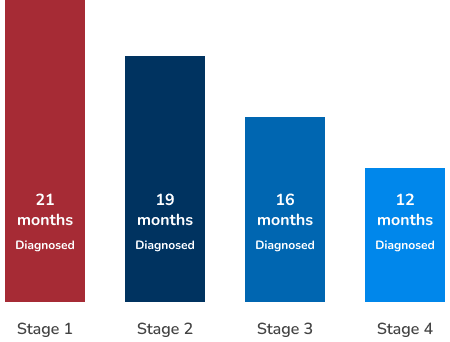Mesothelioma
Life Expectancy
The average life expectancy of mesothelioma patients is 4 to 18 months. In rare cases, mesothelioma patients live for ten years or more. Your life expectancy with mesothelioma will depend on such factors as the stage of disease at diagnosis, the location of your tumor, your age, and your overall health.
Home » National Mesothelioma Law Firm » Mesothelioma Cancer » Mesothelioma Life Expectancy
Medically Reviewed By:
Patricia Shelton, M.D.
- Page Last Updated:
- April 5, 2024
Medically Reviewed By:Patricia Shelton, M.D.
- Page Last Updated:
- April 5, 2024
Ask our experimental AI chatbot.
We have created a revolutionary tool using state-of-the-art artificial intelligence technology that can instantaneously answer questions you have about asbestos exposure and mesothelioma, powered by all of our curated content.
Our AI can answer specifics about mesothelioma cancer, what treatments are available, military asbestos exposure, information about mesothelioma lawsuits and claims, or one of our attorneys, feel free to ask.
Here are some examples of questions you can ask to get started:
- How is mesothelioma diagnosed?
- What are risk factors for developing mesothelioma cancer?
- What is the process for filing a mesothelioma lawsuit?
If you or your loved one has been diagnosed with mesothelioma, no one can tell you exactly what your life expectancy is because every mesothelioma case is unique. Your mesothelioma doctor may provide you with a general estimate, but it is not always possible to predict how fast your disease will spread or how you may respond to treatment.
Patients do not always respond to mesothelioma treatment. However, treatment may improve your life expectancy, particularly if you were diagnosed early and are a candidate for surgery.
What Is the Life Expectancy With Mesothelioma?
The general life expectancy of mesothelioma patients is four to 18 months, but this varies from patient to patient. Your life expectancy could be longer depending on how advanced your mesothelioma is at diagnosis, what treatment options are available, and how well you respond to treatment. While there is no cure for mesothelioma, some patients have lived 10 years or longer after being diagnosed.
Terms Used to Describe Life Expectancy
- Life Expectancy – the length of time a person is likely to live
- Prognosis – the likely outcome of a diagnosis
- Overall survival – the period of time from diagnosis to death
- Median overall survival – the length of time after which half of the patients in a study are still alive
- Progression-free survival – the length of time patients survive without the cancer progressing
Mesothelioma Life Expectancy with Treatment
Mesothelioma life expectancy with treatment ranges from 12 to 48 months after diagnosis. If mesothelioma is diagnosed before it spreads to distant parts of the body, you may have access to life-extending treatments such as surgery, which could help you live five years or more.
Life expectancy and treatment options vary depending on the type of mesothelioma you have been diagnosed with.
Pleural Mesothelioma
Surgical approaches to pleural mesothelioma can more than double life expectancy. Unfortunately, most mesothelioma patients are diagnosed during a late stage when it is too late to benefit from surgery. However, your life expectancy may still increase with systemic treatment, such as chemotherapy and immunotherapy.
- Pleurectomy and decortication – 32 months
- Extrapleural pneumonectomy (lung removal) – 23 months
- Chemotherapy alone – 11.7 months
- Chemotherapy combined with immunotherapy – 17 months
- Chemotherapy combined with radiation – 14.8 months
Dr. Robert Cameron of the West Los Angeles VA Medical Center combines pleurectomy and decortication with radiation and chemotherapy, and many of his patients have significantly outlived their life expectancies while also enjoying a good quality of life.
Peritoneal Mesothelioma
Patients with peritoneal mesothelioma may be able to increase life expectancy significantly with cytoreductive surgery and hyperthermic intraperitoneal chemotherapy, a procedure known as CRS-HIPEC. Patients who undergo CRS-HIPEC have a median survival time of 34 to 92 months, with a survival rate of 29 to 59 percent.
Pericardial Mesothelioma
Patients with pericardial mesothelioma have the lowest survival rates of any other form of mesothelioma, with some studies showing survival times as low as two to six months. Surgical approaches have not been shown to increase life expectancy. Chemotherapy increased the median survival to 13 months in one study.
Testicular Mesothelioma
If testicular mesothelioma is detected early while the cancer is still confined to the testicle, the entire testicle can be surgically removed with little or no health effects, and additional therapies such as chemotherapy or radiation may prevent a recurrence. Nearly half of testicular mesothelioma patients live five years or longer, and as many as a third live at least ten years.
Unfortunately, testicular mesothelioma is very difficult to detect and is often diagnosed after it has spread throughout the body. In these cases, patients must rely on systemic treatments like chemotherapy, which offers a significantly lower survival benefit.
Even if treatment is successful, recurrence of testicular mesothelioma occurs in 52.5 percent of cases, most commonly during the first two years. The median survival time after recurrence is 14 months.
Mesothelioma Life Expectancy Without Treatment
The life expectancy of mesothelioma patients without treatment is four to eight months for most patients due to the rapid growth and spread of mesothelioma. Mesothelioma diagnosis most often occurs during a late stage of the disease. If you happen to be diagnosed during an early stage of mesothelioma, you may live up to a year or slightly longer without treatment.
What Factors Affect Mesothelioma Life Expectancy?
Life expectancy with mesothelioma varies widely based on specific characteristics of the patient and the disease. Patient characteristics that impact life expectancy include age, gender, and overall health status. Disease characteristics that affect life expectancy include the location of the original tumor, the stage of disease when diagnosed, and the mesothelioma cell type.
The Location of the Tumor
Mesothelioma originates in the lining surrounding the lungs, stomach, heart, or testicles. Mesothelioma is categorized into types based on which organ’s lining is affected. The mesothelioma life expectancy differs for the four types of mesothelioma, as shown below.
Type of Mesothelioma
Location of tumor (Linings)
1-Year Survival Rate
3-Year Survival Rate
5-Year Survival Rate
10-Year Survival Rate
Survival Time
Location of tumor (Linings) – Lungs
1-Year Survival Rate – 73%
3-Year Survival Rate – 23%
5-Year Survival Rate – 12%
10-Year Survival Rate – 5%
Survival RateSurvival Time – 4-12 months
Location of tumor (Linings) – Stomach
1-Year Survival Rate – 92%
3-Year Survival Rate – 74%
5-Year Survival Rate – 65%
10-Year Survival Rate – 39%
Survival RateSurvival Time – 6-12 months
Location of tumor (Linings) – Heart
1-Year Survival Rate – 26%
3-Year Survival Rate – 14%
5-Year Survival Rate – 9%
10-Year Survival Rate – None
Survival RateSurvival Time – 3-10 months
The rarest form of mesothelioma is testicular mesothelioma, and survival rates are not reported for this type. However, the general life expectancy for testicular mesothelioma is approximately 24 months.
Mesothelioma Stages and Life Expectancy
The stage of mesothelioma at the time of diagnosis directly affects life expectancy. Staging refers to the progression of disease, including the size of the original tumor and how far the cancer has spread. During the earliest stage of mesothelioma, the tumor is small and has not spread beyond the original site.
When mesothelioma is diagnosed during this stage, life expectancy is higher because surgery may be an option. This allows for the removal of the main tumor before it grows and spreads.
Unfortunately, mesothelioma is most often diagnosed during later stages, after it has already spread to the lymph nodes and distant sites in the body. Surgery often is not an option in these cases. In the rare event that you are a candidate for surgery during this stage, you will still be left with damaging tumors throughout your body.
Below are the differences in life expectancy at the various stages of mesothelioma, according to the Journal of Thoracic Oncology:

Mesothelioma Cell Types
Mesothelioma is further categorized according to the specific characteristics of the cancer cells, and these characteristics affect life expectancy. The three primary cell types are epithelioid, sarcomatoid, and biphasic.
Epithelial mesothelioma is the least aggressive type with a higher treatment response, resulting in the longest life expectancy of all the mesothelioma cell types. According to a German study published in the International Archives of Occupational and Environmental Health, the life expectancy of this cell type is 16.9 months.
Sarcomatoid mesothelioma is the fastest-spreading cell types and also the least responsive to treatment. It is associated with the lowest life expectancy, which is 5.5 months. Fortunately, this is the rarest type.
Biphasic mesothelioma is also known as mixed mesothelioma because it is diagnosed when both epithelial and sarcomatoid cells are observed. The life expectancy for this type is 13.1 months. However, the life expectancy may be higher or lower depending on whether sarcomatoid cells or epithelioid cells are more prevalent.
Age at Diagnosis
Older mesothelioma patients have shorter life expectancies than younger patients. With almost every passing decade, life expectancy decreases by about a year. For example, male patients diagnosed with late-stage pleural mesothelioma at the ages listed below have the following average life expectancies:
Age 40: 4 years
Age 50: 3 years
Age 60: 2 years
Age 70: 2 years
Age 80: 1 year
Most people are past the age of 65 when they are diagnosed with mesothelioma, resulting in an expected life span of two years or less.
Gender and Life Expectancy
The five-year survival rate of women with pleural mesothelioma is nearly triple that of men, at 13.4 percent compared to 4.5 percent in men. In addition, the median survival time for women with peritoneal mesothelioma is 60 months, compared to 43 months for men.
While all the reasons for women’s improved prognosis are still being explored, researchers have found several characteristics in women with mesothelioma that may explain the marked difference in life expectancies:
- Women are often diagnosed at younger ages.
- Women are more likely than men to have the epithelioid cell type.
- Women are more likely to contract peritoneal mesothelioma, which has more treatment options.
- The hormones estrogen and progesterone are more prevalent in women, and they may prolong survival. In fact, post-menopausal women who lacked these hormones have similar survival times as men.
Overall Health
Your overall state of health affects your life expectancy with mesothelioma because it affects how quickly your health may deteriorate because of the cancer. It also determines how well your body can tolerate aggressive treatments, such as surgery and chemotherapy.
A 2016 study found that a mesothelioma patient’s performance status significantly impacted overall survival. Patients with a good performance status (0 or 1) had an overall survival of 16 months, compared with 10.1 months for those with a more impaired performance status.
Improving Mesothelioma Survival
While it is not always possible to increase your life expectancy, some patients have been able to survive longer and improve their quality of life by taking such measures as the following:
- Choose a doctor who specializes in mesothelioma treatment and participates in clinical trials.
- Ask your doctor about novel treatments, such as tumor treating fields, photodynamic therapy, gene therapy, and thermal therapy.
- Obtain multimodal treatment as your health allows. Multimodal treatment is a combined treatment approach that most commonly includes surgery, chemotherapy, and radiation.
Multimodal treatment has increased life expectancy more than threefold in some patients.
Legal Help
A mesothelioma diagnosis is a death sentence imposed on you by companies that knowingly exposed you to asbestos. Our team of experienced asbestos litigators can help you hold these companies accountable and recover compensation to pay for treatment and provide for your family. Contact us today for a free, confidential consultation.
By submitting this form, you agree to our terms & conditions. Please read the full disclaimer



